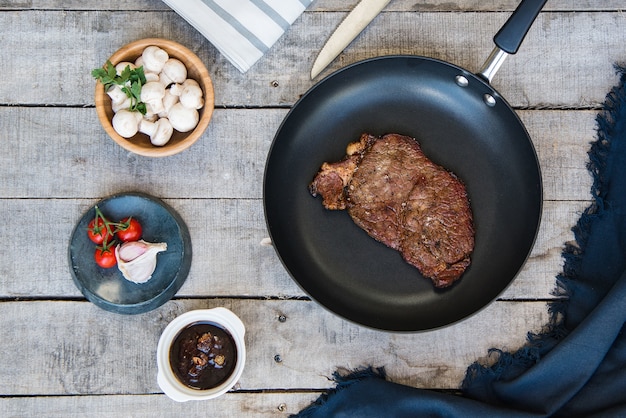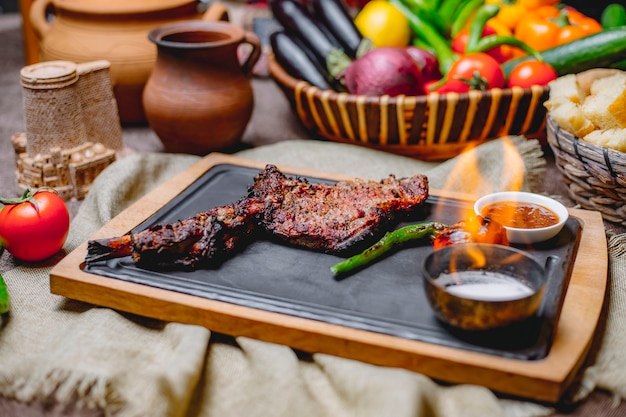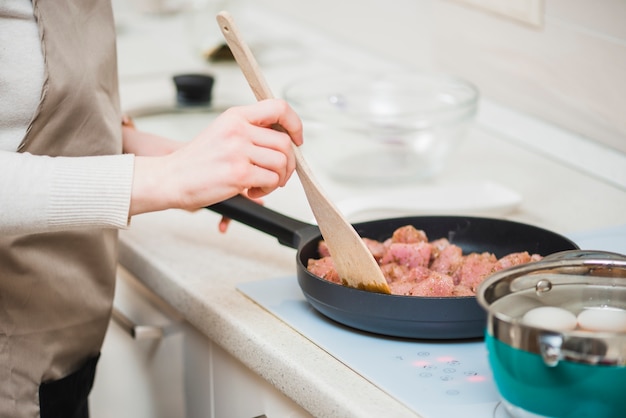Let's be honest, flank steak sometimes gets a bad rap. People tend to think it's tough and chewy, but that's simply not true if you know how to handle it. It's actually a wonderfully flavorful and versatile cut of meat, perfect for a quick weeknight dinner or a fancy dinner party. I've been cooking it for years, and I've learned a thing or two about getting it perfectly tender and juicy. So, buckle up, because I'm about to spill all my secrets!
(Part 1) Choosing Your Flank Steak: The Foundation of a Great Meal

The Cut Makes All the Difference
Think of choosing a flank steak like choosing a good book. You want a story that's well-written and engaging, and in the case of flank steak, you want a cut that's well-marbled and evenly shaped. It's a long, flat muscle with a distinctive grain running through it. It's that grain that we're going to work with later to get the most tender slices possible.
What to Look For: Spotting the Perfect Piece
Color: The ideal flank steak will be a vibrant, deep red, like a ruby under the right lighting. It indicates freshness. Steer clear of anything pale or grey, which suggests it's been sitting around a bit too long.
Marbling: Marbling, those little streaks of fat interlaced within the meat, is your friend. It's like the good fat in a chocolate chip cookie - it adds flavour and keeps the steak moist as it cooks. You want a nice even distribution of marbling throughout the steak.
Texture: A good flank steak will have a firm, springy texture. Think of it like a bouncy tennis ball - it should give slightly when you press it, but still feel firm. Avoid any cuts that feel soft or mushy.
Where to Find It: Your Local Butcher's Treasure Trove
If you're lucky enough to have a friendly butcher in your neighbourhood, that's where I'd recommend going. They'll be able to point you towards the best cuts and even slice it to your preferred thickness. If you're heading to the supermarket, be sure to check the meat counter. Look for a well-presented cut, and don't be shy about asking a butcher for help if you're unsure.
(Part 2) Preparing Your Flank Steak: Taming the Toughness

Tenderizing the Tough Stuff
Now, we need to address the elephant in the room: flank steak is, well, a bit tough. But we're not going to let that stop us. There are a few techniques we can use to tenderize the meat and unlock its full potential.
The Power of Marinades: A Flavour-Infused Bath
Marinating is our first line of defense. It's like giving the flank steak a relaxing spa treatment, soaking it in a flavorful liquid mixture to tenderize and infuse it with amazing aromas.
My Go-To Marinade
I have a marinade that's like a comforting hug in a bowl. It's a combination of soy sauce, olive oil, garlic, ginger, and a touch of honey. This creates a beautiful balance of salty, savory, and sweet flavors. Feel free to get creative and add other elements like lime juice, chili flakes, or even a splash of red wine. I often experiment with different combinations depending on what I'm feeling. Just make sure to let the steak soak in the marinade for at least 30 minutes. The longer you let it marinate, up to 24 hours, the more flavour and tenderness you'll achieve.
The Art of the meat mallet: A Little Muscle Work
Next up, we're going to get a little physical. This is where the meat mallet comes in. It's like a gentle massage for the flank steak, breaking down those tough muscle fibers. You'll be surprised at how much more tender it becomes after a few good whacks. Just be careful not to completely flatten it. We want some thickness for even cooking.
(Part 3) Cooking Your Flank Steak: Mastering the Stovetop

The Stovetop Showdown: Where Heat Meets Flavor
We're going to cook this steak on the stovetop, using a technique called "searing." This is all about getting that beautiful, crispy crust on the outside while keeping the inside perfectly pink and juicy. It's a bit of a dance, but once you get the hang of it, it's incredibly rewarding.
Heat It Up: The Importance of a Hot Pan
Get your trusty cast iron skillet or a heavy-bottomed pan really hot. We're talking high heat here! I usually use medium-high heat, but you might need to adjust based on your stove and pan. You'll know it's ready when the oil shimmers and dances on the surface.
Searing: The Art of the Crispy Crust
Once the pan is smoking hot, add a splash of oil. Now, carefully place the flank steak in the pan, making sure not to crowd it. You want it to have some breathing room to sear evenly.
Don't Flipping Worry: The Patience of a Chef
Cook the steak for about 2-3 minutes per side, or until you have a beautiful, deep brown crust. Resist the urge to poke or prod it too much, let it get that golden-brown sear undisturbed. It's a key step in locking in the juices and developing those rich, savory flavors.
Resting: Letting the Steak Relax
Once the steak is beautifully seared on both sides, remove it from the pan and let it rest for a few minutes. It's like a little time-out for the meat. This allows the juices to redistribute themselves throughout the steak, resulting in a more tender and juicy final product.
(Part 4) Cooking to Perfection: The Steak Whisperer's Guide
Checking for Doneness: Finding the Sweet Spot
We've got the crust, but now it's time to make sure the steak is cooked to our liking. Here's where a bit of intuition and technique come into play.
The Finger Test: Gently press the steak to see how firm it feels. If it's soft and wobbly, it's rare. If it's slightly firm, it's medium-rare. If it's firm and bouncy, it's medium. It's a good starting point, but for a more accurate reading...
A meat thermometer: This is the most reliable way to check for doneness. Insert it into the thickest part of the steak and let it sit for a few seconds. Here are some general guidelines:
| Doneness | internal temperature (°F) | Internal Temperature (°C) |
|---|---|---|
| Rare | 125-130 | 52-54 |
| Medium-Rare | 130-140 | 54-60 |
| Medium | 140-150 | 60-65 |
| Medium-Well | 150-160 | 65-71 |
| Well-Done | 160 | 71 |
Finishing Touches: The Final Flourish
Once the steak is cooked to your liking, remove it from the pan and let it rest for another 5-10 minutes before slicing and serving. While the steak is resting, you can add a knob of butter to the pan. As it melts, pour it over the steak for an extra touch of flavor and richness.
(Part 5) Slicing and Serving: The Art of Presentation
Going Against the Grain: Unlocking Tenderness
Here's a little trick that will make a world of difference. When you slice the flank steak, go against the grain. This means cutting across the long, thin muscle fibers. By slicing this way, you'll make the steak easier to chew and much more tender.
Serving Suggestions: A Delicious Symphony of Flavors
So, what to serve with your perfectly cooked flank steak? The possibilities are endless! Here are a few of my personal favorites, but feel free to experiment and discover your own perfect pairings.
grilled vegetables: Pair the steak with grilled zucchini, bell peppers, and onions for a vibrant and healthy side. The char from the grill complements the steak's smoky notes.
Roasted Potatoes: Crispy, golden roasted potatoes are a classic companion. The combination of textures and flavors is simply irresistible.
A Light Salad: A simple green salad with a vinaigrette dressing balances out the richness of the steak. It adds a refreshing touch to the meal.
Rice: Fluffy white rice or brown rice are great for soaking up the delicious juices. They offer a subtle neutral canvas for the steak's bold flavors.
Pasta: Serve the steak over a bed of pasta tossed with a creamy sauce for a comforting meal. It's a simple yet satisfying way to elevate a weeknight dinner.
(Part 6) Recipes: Where Flavor Meets Function
Flank Steak with chimichurri sauce: A Vibrant Tango of Flavors
This recipe is a celebration of fresh herbs and bright flavors. The chimichurri sauce is a mix of parsley, oregano, garlic, olive oil, red wine vinegar, and a touch of chili flakes. It adds a punch of zest to the steak.
Ingredients:
1 flank steak (about 1.5 pounds)
1 cup chopped parsley
?? cup chopped oregano
4 cloves garlic, minced
?? cup olive oil
?? cup red wine vinegar
1 teaspoon chili flakes (optional)
Salt and pepper to taste
Instructions:
1. Marinate the flank steak in the chimichurri sauce for at least 30 minutes, or up to 24 hours. The longer it marinates, the more intense the flavors will be.
2. Sear the steak on high heat in a cast iron skillet for 2-3 minutes per side. Aim for a beautiful, crispy crust.
3. Reduce the heat to medium and continue cooking for another 5-7 minutes, or until the steak reaches your desired doneness.
4. Let the steak rest for 5-10 minutes before slicing and serving with the remaining chimichurri sauce.
Flank Steak with Asian-Inspired Glaze: A Sweet and Savory Symphony
This recipe takes inspiration from Asian flavors, with a sweet and savory glaze that's both delicious and easy to make.
Ingredients:
1 flank steak (about 1.5 pounds)
?? cup soy sauce
?? cup honey
2 tablespoons rice vinegar
1 tablespoon sesame oil
1 tablespoon grated ginger
2 cloves garlic, minced
1 teaspoon black pepper
Instructions:
1. Marinate the flank steak in the glaze for at least 30 minutes, or up to 24 hours.
2. Sear the steak on high heat in a cast iron skillet for 2-3 minutes per side.
3. Reduce the heat to medium and continue cooking for another 5-7 minutes, or until the steak reaches your desired doneness.
4. While the steak is resting, bring the remaining glaze to a simmer in a small saucepan. This will thicken the glaze slightly.
5. Pour the glaze over the steak before slicing and serving. The heat from the steak will melt the glaze, creating a beautiful, glistening coating.
Flank Steak with Garlic Butter: A Simple Classic
This recipe is simple, classic, and guaranteed to please. The garlic butter adds a richness and depth of flavor to the steak.
Ingredients:
1 flank steak (about 1.5 pounds)
4 tablespoons butter
4 cloves garlic, minced
Salt and pepper to taste
Instructions:
1. Marinate the flank steak in a simple mixture of salt and pepper for at least 30 minutes.
2. Sear the steak on high heat in a cast iron skillet for 2-3 minutes per side.
3. Reduce the heat to medium and continue cooking for another 5-7 minutes, or until the steak reaches your desired doneness.
4. While the steak is resting, melt the butter in a small saucepan over low heat. Add the minced garlic and stir until fragrant.
5. Pour the garlic butter over the steak before slicing and serving. The butter will melt over the steak, creating a rich and flavorful sauce.
(Part 7) Leftovers: A Delicious Second Act
The Next Day's Delight
Let's face it, sometimes we end up with leftovers. But, instead of seeing them as a disappointment, think of them as a bonus! Flank steak is great for leftovers because it holds up well and can be used in a variety of ways.
Creative Leftover Ideas
Steak Sandwiches: Slice the leftover flank steak thinly and pile it on crusty bread with your favorite toppings. Add some cheese, lettuce, tomato, and aioli for a satisfying sandwich.
Steak Salad: Chop the leftover flank steak into bite-sized pieces and toss it with a salad. A mix of greens, grilled vegetables, and a tangy dressing makes for a light and flavorful meal.
Steak Stir-Fry: Slice the leftover flank steak into thin strips and stir-fry it with your favorite vegetables and sauce. Use a stir-fry sauce with soy sauce, ginger, and garlic for a quick and delicious dinner.
Steak Soup: Cube the leftover flank steak and add it to a hearty soup. A beef broth base with vegetables, noodles, and a dollop of sour cream is a great way to use up leftovers.
(Part 8) FAQs: The Questions You Might Have
1. Can I cook flank steak in the oven?
Yes, you can cook flank steak in the oven. Preheat your oven to 350°F (175°C) and bake the steak for 15-20 minutes, or until it reaches your desired doneness. Remember to let the steak rest for a few minutes before slicing.
2. What if my flank steak is too thick?
If your flank steak is too thick, you can butterfly it by slicing it almost all the way through, then opening it up and flattening it. This will help it cook more evenly. It's a good idea to tenderize it with a meat mallet before cooking.
3. What if my flank steak is too thin?
If your flank steak is too thin, you can cook it for a shorter amount of time, and be careful not to overcook it. It's also a good idea to marinate the steak for a longer period to help tenderize it.
4. What can I serve with flank steak besides potatoes and vegetables?
As I mentioned earlier, there are so many things you can serve with flank steak. You could try: mashed sweet potatoes, couscous, quinoa, roasted brussels sprouts, asparagus, or even a simple salad with a lemon vinaigrette. It's all about finding the flavors that you enjoy.
5. Can I freeze flank steak?
Yes, you can freeze flank steak. Wrap it tightly in plastic wrap or aluminum foil, then place it in a freezer-safe bag. It will keep in the freezer for up to 3 months. Remember to thaw it in the refrigerator overnight before cooking. This is a great way to have flank steak on hand for busy weeknights.
Everyone is watching

How to Cook Frozen Lobster Tails Perfectly: A Step-by-Step Guide
RecipesLobster. Just the word conjures up images of lavish meals, special occasions, and a taste of luxury. But let's...

Pigs in a Blanket Cooking Time: How Long to Bake for Perfect Results
RecipesAh, pigs in a blanket. Just the name conjures up images of those delightful little parcels of crispy pastry en...

Pork Fillet Cooking Time: How Long to Cook It Perfectly
RecipesPork fillet, or tenderloin as it's sometimes called, is a real favourite in our house. It's so versatile, and...

The Ultimate Guide to Cooking Sweet Potatoes: From Roasting to Mashing
RecipesSweet potatoes. Just the name conjures up images of warm, comforting dishes, bursts of vibrant color, and a to...

The Ultimate Guide to Tender, Juicy Pulled Pork
RecipesRight, let's talk pulled pork. It's one of those dishes that just screams "comfort food," doesn't it? I mean...
